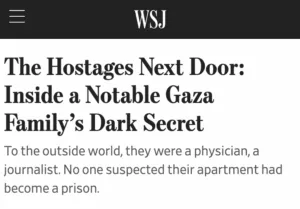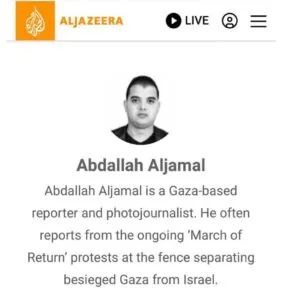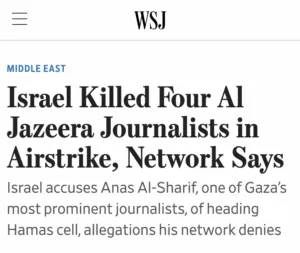RSS
Wall Street Journal vs. Wall Street Journal: A Paper at War With Its Own Reporting

The Al Jazeera Media Network logo is seen on its headquarters building in Doha, Qatar, June 8, 2017. Photo: REUTERS/Naseem Zeitoon
Just over one year ago, HonestReporting highlighted a striking dichotomy within The Wall Street Journal — while its opinion pages often feature robust defenses of Israel and incisive commentary on the Middle East, its news coverage has charted an increasingly troubling course.
This isn’t simply about tone. It’s about fundamental inconsistencies within the Journal’s own reporting that reveal a creeping bias — contradictions that should concern anyone who values accurate journalism. To illustrate how far its news pages have drifted, consider two stories that bookend just over 12 months of WSJ coverage. Both involve Hamas and individuals with media credentials, but the difference in framing is stark.
When the Truth Was Told
In June 2024, the WSJ published a deeply reported feature, “The Hostages Next Door: Inside a Notable Gaza Family’s Dark Secret.”
It revealed how an outwardly respectable family — a doctor and a journalist who contributed to Al Jazeera — held three Israeli hostages captive in their Gaza apartment at the behest of Hamas.

The Journal reported:
It was common knowledge in Nuseirat that the Al-Jamal family was close to Hamas, according to local residents who spoke to The Wall Street Journal. But they said few people… knew of the secret locked in the small, darkened room in the family’s apartment.
The hostages and Israeli security forces have said their captors included Al-Jamal’s son, 37-year-old Palestinian journalist Abdullah Al-Jamal.
From their locked room, the hostages could hear Abdullah — a Hamas operative moonlighting as a “journalist” — going about his daily life with his family.
This echoed what HonestReporting had already exposed months earlier: numerous Gaza-based “journalists” were not neutral observers but active participants in Hamas’ terror machine, including the October 7 massacre.
Although the WSJ didn’t note it, Al Jazeera publicly denied any link to Abdullah Al-Jamal — even as he appeared on their website, complete with byline and photograph. That denial, later proven false, is part of a consistent pattern: Al Jazeera repeatedly distances itself from individuals later exposed as active Hamas operatives.

When the Truth Was Buried
Fast forward to August 2025. The WSJ covered an IDF strike that killed four Al Jazeera journalists, including Anas Al-Sharif. The headline reads: “Israel Killed Four Al Jazeera Journalists in Airstrike, Network Says.”
The subhead: “Israel accuses Anas Al-Sharif, one of Gaza’s most prominent journalists, of heading Hamas cell, allegations his network denies.”

Notice the shift: The headline’s focus is that Israel “killed journalists,” filtered explicitly through Al Jazeera’s lens. Israel’s evidence-backed claim that Al-Sharif commanded a Hamas cell is demoted to a subordinate clause and hedged with “allegations his network denies.”
Where the June 2024 piece treated Hamas’ exploitation of journalistic cover as fact, the 2025 piece presents it as a contested claim — even though the WSJ’s own reporting has already documented this exact Hamas tactic. The failure to apply its own prior context is not just sloppy; it undermines reader trust.
Why This Matters — and How to Stop the Drift
This isn’t nitpicking. Headlines shape reader perceptions far more than buried paragraphs. When Israel’s claims are framed as dubious while Hamas-linked outlets’ denials are given equal weight, the result is distortion.
Bias doesn’t always announce itself with screaming editorials. Often, it creeps in through headline framing, asymmetric skepticism, and a refusal to connect the dots the paper has already laid out.
The solution is simple: consistency. If the WSJ has the courage to expose Hamas’ use of “journalists” when reporting on hostage rescues, it should apply the same factual clarity when reporting on IDF strikes against Hamas operatives with press credentials. Evidence should not be treated as a mere “allegation” when its own prior work substantiates the pattern.
What Can Readers Do?
Calling this out matters. Letters to the editor are one avenue, but they aren’t enough on their own. Large outlets like the WSJ take notice when:
- Readers demand accountability publicly: Share clear examples of the contradictions (like the two pieces above) on social platforms, tagging the reporters and editors.
- Subscribers vote with their wallets: If you’re a WSJ subscriber, tell them directly that you will reconsider your subscription if their news reporting continues to contradict their own documented facts.
- Advertisers hear about it: Major outlets pay attention when their advertisers are contacted with concerns about inconsistent or misleading reporting.
Public pressure works best when it highlights specific failures with receipts — the June 2024 and August 2025 pieces are a textbook example.
The Wall Street Journal is capable of excellent journalism. But until its news desk aligns with its own facts rather than undermining them, its credibility will remain in question.
The author is a contributor to HonestReporting, a Jerusalem-based media watchdog with a focus on antisemitism and anti-Israel bias — where a version of this article first appeared.
RSS
After False Dawns, Gazans Hope Trump Will Force End to Two-Year-Old War

Palestinians walk past a residential building destroyed in previous Israeli strikes, after Hamas agreed to release hostages and accept some other terms in a US plan to end the war, in Nuseirat, central Gaza Strip October 4, 2025. Photo: REUTERS/Mahmoud Issa
Exhausted Palestinians in Gaza clung to hopes on Saturday that US President Donald Trump would keep up pressure on Israel to end a two-year-old war that has killed tens of thousands and displaced the entire population of more than two million.
Hamas’ declaration that it was ready to hand over hostages and accept some terms of Trump’s plan to end the conflict while calling for more talks on several key issues was greeted with relief in the enclave, where most homes are now in ruins.
“It’s happy news, it saves those who are still alive,” said 32-year-old Saoud Qarneyta, reacting to Hamas’ response and Trump’s intervention. “This is enough. Houses have been damaged, everything has been damaged, what is left? Nothing.”
GAZAN RESIDENT HOPES ‘WE WILL BE DONE WITH WARS’
Ismail Zayda, 40, a father of three, displaced from a suburb in northern Gaza City where Israel launched a full-scale ground operation last month, said: “We want President Trump to keep pushing for an end to the war, if this chance is lost, it means that Gaza City will be destroyed by Israel and we might not survive.
“Enough, two years of bombardment, death and starvation. Enough,” he told Reuters on a social media chat.
“God willing this will be the last war. We will hopefully be done with the wars,” said 59-year-old Ali Ahmad, speaking in one of the tented camps where most Palestinians now live.
“We urge all sides not to backtrack. Every day of delay costs lives in Gaza, it is not just time wasted, lives get wasted too,” said Tamer Al-Burai, a Gaza City businessman displaced with members of his family in central Gaza Strip.
After two previous ceasefires — one near the start of the war and another earlier this year — lasted only a few weeks, he said; “I am very optimistic this time, maybe Trump’s seeking to be remembered as a man of peace, will bring us real peace this time.”
RESIDENT WORRIES THAT NETANYAHU WILL ‘SABOTAGE’ DEAL
Some voiced hopes of returning to their homes, but the Israeli military issued a fresh warning to Gazans on Saturday to stay out of Gaza City, describing it as a “dangerous combat zone.”
Gazans have faced previous false dawns during the past two years, when Trump and others declared at several points during on-off negotiations between Hamas, Israel and Arab and US mediators that a deal was close, only for war to rage on.
“Will it happen? Can we trust Trump? Maybe we trust Trump, but will Netanyahu abide this time? He has always sabotaged everything and continued the war. I hope he ends it now,” said Aya, 31, who was displaced with her family to Deir Al-Balah in the central Gaza Strip.
She added: “Maybe there is a chance the war ends at October 7, two years after it began.”
RSS
Mass Rally in Rome on Fourth Day of Italy’s Pro-Palestinian Protests

A Pro-Palestinian demonstrator waves a Palestinian flag during a national protest for Gaza in Rome, Italy, October 4, 2025. Photo: REUTERS/Claudia Greco
Large crowds assembled in central Rome on Saturday for the fourth straight day of protests in Italy since Israel intercepted an international flotilla trying to deliver aid to Gaza, and detained its activists.
People holding banners and Palestinian flags, chanting “Free Palestine” and other slogans, filed past the Colosseum, taking part in a march that organizers hoped would attract at least 1 million people.
“I’m here with a lot of other friends because I think it is important for us all to mobilize individually,” Francesco Galtieri, a 65-year-old musician from Rome, said. “If we don’t all mobilize, then nothing will change.”
Since Israel started blocking the flotilla late on Wednesday, protests have sprung up across Europe and in other parts of the world, but in Italy they have been a daily occurrence, in multiple cities.
On Friday, unions called a general strike in support of the flotilla, with demonstrations across the country that attracted more than 2 million, according to organizers. The interior ministry estimated attendance at around 400,000.
Italy’s right-wing government has been critical of the protests, with Prime Minister Giorgia Meloni suggesting that people would skip work for Gaza just as an excuse for a longer weekend break.
On Saturday, Meloni blamed protesters for insulting graffiti that appeared on a statue of the late Pope John Paul II outside Rome’s main train station, where Pro-Palestinian groups have been holding a protest picket.
“They say they are taking to the streets for peace, but then they insult the memory of a man who was a true defender and builder of peace. A shameful act committed by people blinded by ideology,” she said in a statement.
Israel launched its Gaza offensive after Hamas terrorists staged a cross border attack on October 7, 2023, killing some 1,200 people and taking 251 people hostage.
RSS
Hamas Says It Agrees to Release All Israeli Hostages Under Trump Gaza Plan

Smoke rises during an Israeli military operation in Gaza City, as seen from the central Gaza Strip, October 2, 2025. Photo: REUTERS/Dawoud Abu Alkas
Hamas said on Friday it had agreed to release all Israeli hostages, alive or dead, under the terms of US President Donald Trump’s Gaza proposal, and signaled readiness to immediately enter mediated negotiations to discuss the details.

